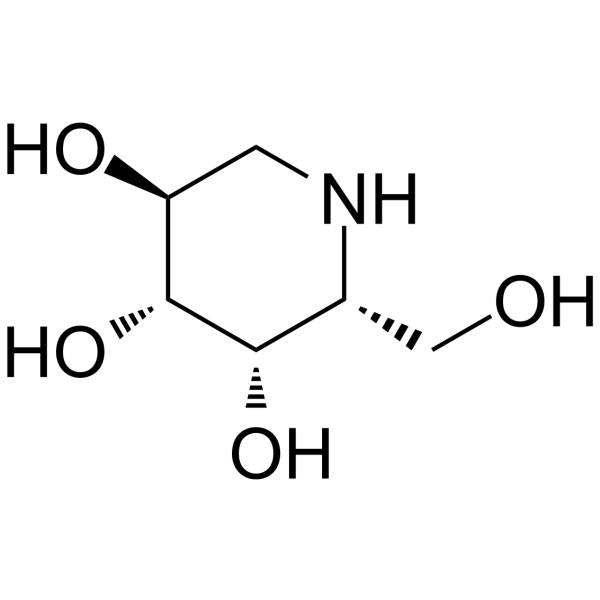108147-54-2
| Name | deoxygalactonojirimycin, hydrochloride |
|---|---|
| Synonyms |
capric acid-d19
MIGALASTAT perdeuterodecanoic acid Capric acid-d19,OH (3S,5S,2R,4R)-2-(HYDROXYMETHYL)PIPERIDINE-3,4,5-TRIOL Decanoic-d19 acid decanoic acid-d19 |
| Description | Migalastat (GR181413A (free base)) is an orally active and competitive inhibitor of α-galactosidase A (α-Gal A) with an IC50 of 0.04 μM for human α-Gal A[1]. |
|---|---|
| Related Catalog | |
| Target |
IC50: 0.04 μM (human α-Gal A)[1]; Ki: 0.04 μM (human α-Gal A)[1] |
| In Vitro | Both IC50 and Ki values of Migalastat toward human lysosomal a-Gal A are 0.04 μM[1]. Cell Viability Assay[4] Cell Line: EHK cells mutated α-Gal A Concentration: 10 μM Incubation Time: 9 days Result: Reduced Gb3 accumulation and lysosome volume. |
| In Vivo | Fabry disease is an X-linked recessive disorder caused by the deficient activity of α-galactosidase A[2]. Migalastat (oral gavage, 3 mg/kg daily for 4 weeks) increases α-Gal A activity in heart, kidney, spleen, and liver in a dose- and time-dependently in transgenic mice that express human mutant alpha-Gal A (TgM)[2]. Migalastat shows the half-life of less than 1 day in all major issues in TgM for 2 weeks pretreatment[2]. Migalastat (oral gavage, 100 mg/kg daily for 28 days) to transgenic mice reduces lyso-Gb3 levels up to 64%, 59%, and 81% in kidney, heart, and skin, respectively[3]. Animal Model: Male nontransgenic (Non-Tg) C57BL/6 mice; transgenic mice expressing human mutant R301Q α-Gal A (TgM), α-Gal A knockout mice (KO), mice express human R301Q α-Gal A in a null background (TgM/KO)[2] Dosage: 3 mg/kg Administration: Oral gavage; every day for 4 weeks Result: Reduced Globotriaosylceramide (Gb3) storage remarkably in kidney of mice. |
| References |
| Density | 1.456g/cm3 |
|---|---|
| Boiling Point | 361.1ºC at 760 mmHg |
| Molecular Formula | C6H13NO4 |
| Molecular Weight | 163.17200 |
| Flash Point | 197.3ºC |
| Exact Mass | 163.08400 |
| PSA | 92.95000 |
| Vapour Pressure | 1.13E-06mmHg at 25°C |
| Index of Refraction | 1.582 |
